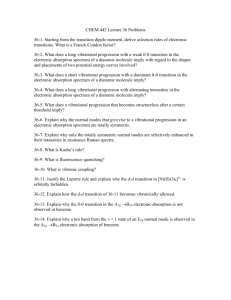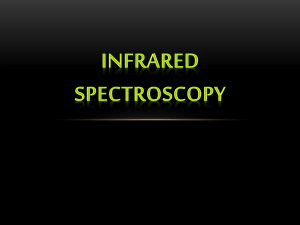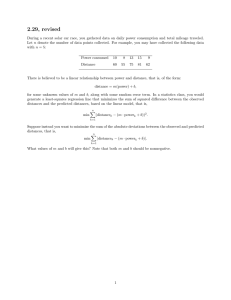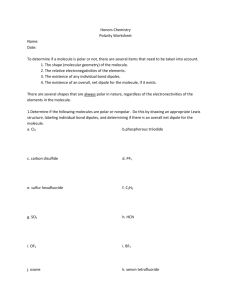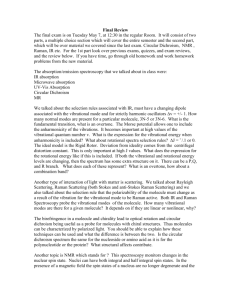ROTATIONAL ABSORPTION SPECTRUM OF OCS ~ T. WENTINK, JR.
advertisement
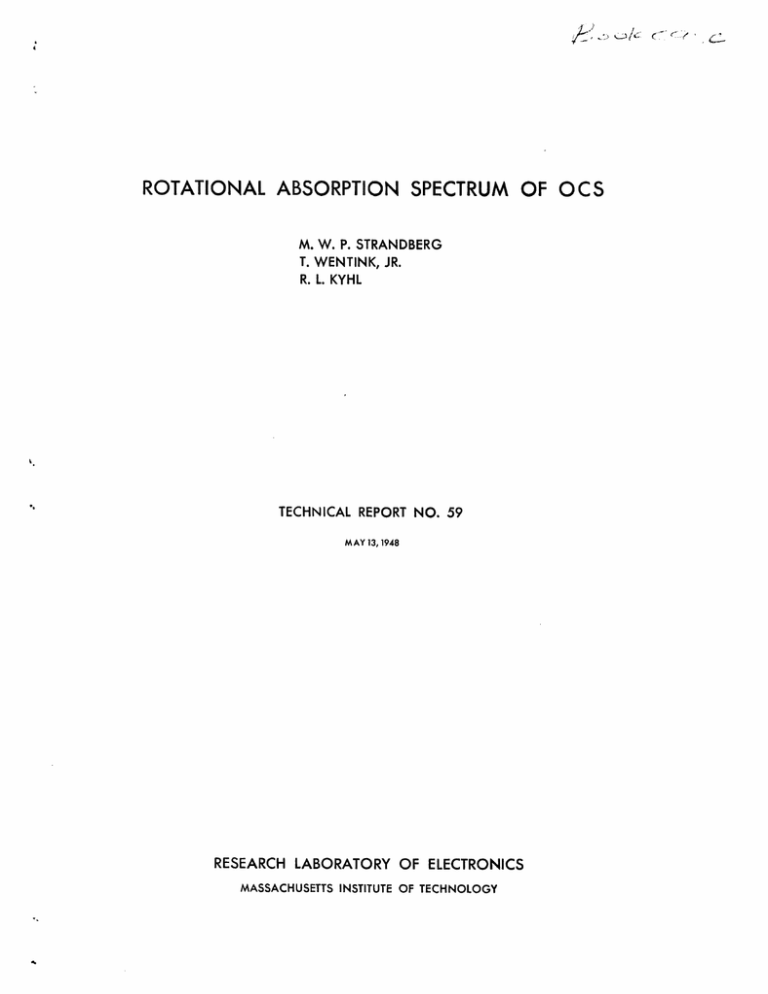
I )-/ (--r ?
1)~~~~~~
~
ROTATIONAL ABSORPTION SPECTRUM OF OCS
M. W. P. STRANDBERG
T. WENTINK, JR.
R. L. KYHL
TECHNICAL REPORT NO. 59
MAY 13,1948
RESEARCH LABORATORY OF ELECTRONICS
MASSACHUSETTS INSTITUTE OF TECHNOLOGY
The research reported in this document was made possible
through support extended the Massachusetts Institute of Technology, Research Laboratory of Electronics, jointly by the Army
Signal Corps, the Navy Department (Office of Naval Research),
and the Air Force (Air Materiel Command), under the Signal
Corps Contract No. W-36-039 sc-32037.
MASSACHUSETTS
INSTITUTE
OF
TECHNOLOGY
Research Laboratory of Electronics
Technical Report No. 59
May 13, 1948
ROTATIONAL ABSORPTION SPECTRUM OF OCS
M. W. P. Strandberg
T. Wentink, Jr.
R. L. Kyhl
Abstract
Extended measurements in the microwave rotational
spectrum of carbonylsulfide (OCS) are presented and correlated with
the data obtained by other investigators.
Precision measurements of
rotational transitions for Jl-J2--;
J
J4-5 allow the
evaluation of precise reciprocal moments of inertia in the ground
vibrational state, and the centrifugal distortion coefficient.
From frequencies observed for 01 6 c1 2 S3 2, O1 6 01 3 S3 2 , and 01 6 C1 2 S3 4
internuclear distances have been calculated.
Equilibrium moments of
inertia and internuclear distances cannot as yet be given, since thus
far only one of the three vibrational-rotational interaction coefficients (a2) has been reported. Theoretical considerations involving
such equilibrium data are discussed. Data on -doubling in
o1 6 C1 2 S3 ,2
l06C13S32 and 016C14S 3 2 are presented. The Stark effect
of carbonylsulfide has been measured in 01 6 1C 2S$ 2 and O1 61C 3 s3 2 .
These measurements lead to the evaluation of the dipole moment and
indicate the effect of isotopic changes on the dipole moment.
I"
.1
ROTATIONAL ABSORPTION SPECTRUM OF OCS
Carbonyl sulfide (OCS) is known to be a linear molecule. In this
paper we have attempted to correlate existing information regarding the
structure of this molecule which may be deduced from the rotational absorption
spectrum, and to give extended measurements in order to allow a unified
presentation. We wish to point out that several other investigators have
been instrumental in obtaining much of the experimental and theoretical data
considered below.
1.
General Theory
The rotational contribution to the energy levels of an unperturbed
linear rotor in any vibrational state can be shown to be1
=
2] hcBv -
[J(J+)
[J(J+1) -
hcDv
(1)
where W is in ergs,
J = total orbital angular momentum quantum number
=
h
=
c
=
B-
Bv =
Dv=
quantum number of angular momentum parallel to figure axis due
to a degenerate bending vibration
Planck's constant
speed of light
"reciprocal moment of inertia" in cm 1 .
-1centrifugal
distortion
coefficient
in
cm
centrifugal distortion coefficient in cm
Thus, from the Bohr frequency condition and the selection rule
AJ = +1, rotational transitions are induced in a molecule with an electric
dipole moment by radiation with frequencies in cycles/sec given by
J-~J+l
=
2
cBv(J+l) -
4
cDv EJ+l)3 -
2(J+l
(2)
The "reciprocal moment of inertia" of the molecule in any vibrational state is related to the moment of inertia with the atoms in the minima
of the vibrational potentials through the relation
Bv
=
Be-
:
-1-
ai(vi + 2
)
(3)
-rhere B
I
=
h
cm
82
8n2I c
e
equilibrium moment of inertia
i
=
index over all vibrational states
vi
=
vibrational quantum number
di
=
degeneracy of vibration:
a
=
coefficient measuring vibration-rotation inter-
e
e
1,2,.
action in cm
It should be noted that this representation is the usual one; in
view of present knowledge it would be better, perhaps, to sum over all vibrational states separately instead of grouping the degenerate ones. For
example, in a linear triatomic molecule it is known that the bending vibration
is doubly degenerate since two orthogonal planes may be passed through the
figure axis. Yet the vibration-rotation interaction is different for the two
degenerate vibrations, so that the rotational absorption has a doublet
structure when the molecule is in the bending vibrational state (vI = v 3 = 0;
v2 = 1). This splitting is referred to as -doubling. The difference of the
displaced rotational energy levels in the two bending modes is given by
AWj
=
hqJ(J+l)
ergs,
(4)
and the two absorption lines (J-J+l) are detected at frequencies different
by
L
=
2cq(J+l)
where Av is in cycles/sec, and q is a measure of the
difference of vibrational-rotational interactions,in cm 1 .
In other words, the two bending vibrational modes have different
interaction coefficients (2); if the average is used in the standard form
for B v the same results are obtained as if, more correctly, every mode were
summed over independently. The theory of -type doubling has been discussed
by Herzberg2 and calculations have been made by H. H. INielson and W. H.
Shaffer .
The term values may also be perturbed by external fields. In the
presence of an electric field the energy levels of a molecule with n electric
dipole moment are perturbed because of the interaction of the rotating dipole
with the static electric field, i.e., the Stark effect. This perturbation
energy for linear molecules in the ground vibrational state is of second
order and has been shown to be 4
ce_
W(2)
J,m
where m
tL
E
4Te
2
h2
I
JJ+l) - 3m2
J(J+ (2J-1) (2J+3)
(5)
= magnetic quantum number and Iml - J
= eectric dipole moment
= electric field strength.
Thus,-the original transition has the spatial degeneracy partly
removed and the frequencies for induced transitions are now given by
((StarkJ-J+l
(Vo)J-J+l +
v
.(6)
The selection rule AJ = +1, Am = 0 applies when the Stark field is parallel
to the electric vector of the incident radiation, and this is the case in
these experiments. This is called a n-type transition and is the only case
which will be considered in this paper. When Am = 0,
6m2(16J2 + 32J+10
Sj(J+1)2(J+2)
= J(J+2)(2J-i)(J+l)(2J+3)(2J+5)
2
h2
o
The perturbation of the energy levels given by Eq. (5) are indicated in
Fig. 1. The absorption spectrum for a given isotopic configuration with and
without a Stark field is indicated in Fig. 2.
For the transition J-J+l, Am = O, the square of the dipole
direction cosine matrix element has a
J+1)2 - m dependence. Therefore,
the intensity of each component follows a c[J+1) 2 - m2 ] law;
= 1 when
m = 0 and
= 2 for O< Iml J, because of the spatial degeneracy of the
+ and -m levels.
The study of the rotational absorption spectra of a molecule with
various isotopic compositions with and without knorwn electric fields can be
used to deduce certain physical quantities.5 First, if the vibrational
interaction energies are ignored for zero-point vibrations, i.e., with a
rigid rotor approximation, interatomic distances may be calculated if as
many isotopic forms of the molecule are studied as there are structural
parameters.
Thus, in a linear unsymmetrical triatomic molecule with known
atomic masses ml, m 2 , m3 , the moment of inertia is a function of the two
interatomic distances, r1 2, r2 3 . One may then solve the following set of
equations for the interatomic distances r 2 and r2 3 .
-3-
m
4
4
-4
______
UNPERTURBED LEVELS
PERTURBED BY STARK FIELD
(PERTURBED AND UNPERTURBED
LEVELS NOT TO SAME SCALE)
¶
_E--------
3
---------
ii
Z
w
z
w
2
_-::: - -- Tr--------srJ
___---
0
±1
±2
I
VI/ st
/---I-
-- - - - - --
-
0
.1
I
`-""-"'
L~~~~~~~~~~~~~~~
±1
0
II----------------- ---
J
Fig. 1.
o
m
Energy levels in
-4-
a rigid linear rotor.
--
(
6
5
en
z
z
w4
I
*
UNPERTURBED SPECTRUM
STARK SPECTRUM
J
I-i
2
it2
+3
m=OA
0
i
1'
j0O
^I
\----------Y
1
J=O-..
NI
\N
I
\t
i
--
v,
J=I-2
Fig. 2.
--. L-----------~l
N
N
V
Theoretical spectrum of a rigid linear rotor.
Separation of unperturbed lines = 2B . Frequency
scale about unperturbed lines expanded to show
relative shifts in Stark effect.
I(ml m2 m3 r1 2 r2 3 )
:
2(J+l)h
8nvo
2(J+l)h .
(mlm2m3r12r2)3
-
8T2VI
The primes refer to the isotopically different molecule.
If absorptions are detected for the isotopic molecules in the
ground vibrational state for two different J transitions, the centrifugal
distortion energy can be evaluated (see Eq. (1)). Also if one J transition
for each of the excited vibrational states is observed, the zero-point
vibrational energy can be eliminated and the equilibrium moment of inertia
can be evaluated. In this way the true equilibrium interatomic distances can
be computed.
The vibrational-rotational interaction energies must be used
in the precise evaluation of the interatomic distances, since only the
equilibrium distances may be assumed to be independent of nuclear mass
changes.6
Secondly, the dipole moment of the molecule may be calculated for
the molecule in any given vibrational state, and for any isotopic form, by
measuring the Stark effect in that vibrational state in a known, homogeneous
electric field. The cdipole moment may also be inferred from the line
intensities, since the absorption coefficient ma x in cm- 1 can be shown to be
4rr2Nhv3L2
.0
2
2
-hcBvJ(J+1)/kT
e
3k T Avc
where N o
=
molecular density (molecules/unit volume)
h
=
Planck's constant
v
=
resonant frequency
=
dipole moment
k
=
Boltzmann constant
T
=
gas temperature in OK
Av
=
half breadth of absorption at half intensity.
However, the dipole moment may not be evaluated by this method -ith facility or
accuracy since the measurement of absolute absorption depends upon so many
things; e.g., the purity of the sample, the calibration of the measuring
system, etc.
2.
Experimental Method
Some knowledge of the structure of OCS is available from electron7
diffraction data.
Such information is useful in calculating the reciprocal
moment to an accuracy sufficient for a preliminary prediction of the spectral
line frequencies to be expected in the microwave region. Alternatively, the
bond distances may be calculated from the resonant bond model of Pauling.8
A number of investigators have studied the absorption of OCS in the
2'
4
24000-Mc/sec region9 ' 101' 1 ' ,13,1
and Dakin, Good, and Coles have reported
some preliminary Stark measurements.
The absorption lines studied by us were detected with an apparatus
wThich has come to be known as a sweep spectroscope. The frequencies were
measured with a secondary frequency standard calibrated with the National
-6-
Bureau of Standards frequency signals transmitted by WV. We will outline
only briefly both of these instruments.
The seep spectroscope is roughly of the type in general use in
the field of microwave spectroscopy.l5
apparatus.
Figure 3 is a block diagram of the
The absorption cell used for these measurements consists of 9.75
meters of 3-cm
brass waveguide equipped with an electrode for the applica-
tion of the Stark field.
SIGNAL
Figure
MICA
3
a shows the electrode orientation.
ABSORPTION
MICA
LOCAL
OR
Li
a
-I
)
FIG. 3 -a
CROSS SECTION ABSORPTION CELL
Fig. 3.
Block diagram of microwrave spectroscope.
Figure 4 is a picture of the 0O612S32 absorption J = 1-)2. The
line is scuare-?rave Stark-modulated at a low frequency so that the unperturbed
and perturbed absorptions appear in alternate time intervals. Figure 5
shows the same absorption as it appears thru a 6-kc/sec amplifier.
The sweep
of Fig. 4 has been expanded considerably compared with that of Fig. 5. The
m = 0 line is on the right; m =
1 line is on the left.
It is apparent that
the sum of the individual absorptions equals the unperturbed absorption
(center) and that their intensities obey the expected c(22 -m 2 ) relation.
-7-
Fig. 4.
Fig. 5.
Strl:
Stark effect in COS Jl-2'
effect in COS J-2 (Signal
thirough narorband 6-c/sec amplifier).
The type of frequency standard used is described in Vol. 11 of
the M.I.T. Radiation Laboratory Series 1 6 and is shown schematically in Fig. 6.
The frequency standard "pip" is generated by the beating of the frequencyswept signal generator of the spectroscope with the frequency standard signal.
If this "pip" is made to coincide in time with an absorption line, the
standard frequency will be set at the line frequency plus or minus the pip
amplifier i-f frequency. Therefore, the standard is set higher and lower
than the line frequency, by an amount equal to the pip amplifier i-f frequency,
-8-
OR
SCOPE
Fig. 6.
Block diagram of frequency measurement scheme.
and these two readings are made.
The average of these two readings is the
actual molecular absorption frequency.
3.
Experimental Data
Measurements of the OCS spectrum are given in Table I. The
J = 1-42 and J = 2-)3 transitions were measured with 2K33-type klystron
generators. The J = 3-e4 and J = 4--5 transitions were measured Ewith this
same type of oscillator by using the second-harmonic energy generated when
the fundamental radiation is applied to a non-linear silicon crystal.
It should be noted that the error quoted is not a probable error.
The standard is adjusted to WWV to at least 2 parts in 10 . Doppler shift
in transmissions from WWV due to fading appears to be less than one part in
7
8
107 and WWV itself is claimed to be accurate to two parts in 10 . The
absorption lines are generally less than 200 kc/sec wide when measured
-9-
TABLE I.
MIolecule
Observed Absorption Frequencies
vl v2 vrerecy
V2 Vs
Transition
_________1
0o1612S3 2
Reference
Mc/sec.
1-2
1- 2
1-'2
2-3
3- 4
4--5
0
0
0
0
0
0
016C12S33
1- 2
0 0 0
24020.3
o01612S34
1-2
3- 4
0 0 0
0 0 0
23731.33 + .03
47462.40 _ .05
13S3 2
1- 2
1- 2
0 0 0
0 1 0
01 0
0 00
0 1 0
0 1 0
24247.82
24301.05
24275.25
24173.0
24224.0
24197.0
0
1 14S21--2
1-2
1--2
1---2
01601432
24325.92
24380.70
24355.49
36488.82
48651.64
60814.08
0 0
1 0
1 0
0 0
0 0
00
+ .C01
_
+
t
+
+
.2
.2
.03
.05
.05
.1
(12)
(13)
+ .03
+ .2
.2
+ 1.
+ 1.
_ 1.
(14)
(14)
(14)
TABLE II. Derived Constants for OCS
Term Value Parameters
1
Molecule
Bo cm
01601 2 S3 2
.202864
138.0
16 12 33
0 C S
.200319
139.7
016012S34
.197910
141.4
.202216
138.4
6.45
.03
.20159
138.8
6.7
.
O16C
13
S
01 6 01 4 S3 2
| I
xo1074° 2
cDv cycles/sec
1600 + 50
cq M/sec
ca2 Mc/sec
6.31 ± .03
-10.54 + .1
Reference
(12)
1400 + 100
-10.08
-9.4
.12
+ .
(14)
Internuclear Distances
r (C=O)
Covalent Radii 1.17 A
OC0
1.1632
SOS
OCS
1.1637 ± .0013
OCS
1.16
+ .02
re(C=O)
ro(C=0)
1.54
A-
re(C=S)
ro(S=C=0)
3.71 A.
1.1615 A
'
1.554
1.5586 + .0010*
1.56
± .03
(R)
(1)
(1)
3.722?3 + .0003'
3.72
+ .05
(4)
Error determined from internal consistency of distances calculated from various
isotopic forms; see text.
-10-
Ref.
and readings are made to 4 arts in 107. The J = 1-2 line of 01 6 O1 2 3 2 has
been measured many tes over a period of 3 months giving results 1which are
constant within + 10 kc/sec.
The error quoted is thus large enough to insure
reproducibility of the lines measured.
These data may be immediately reduced to yield the centrifugal
stretching coefficient, the moments of inertia of the molecules in the ground
vibrational state, and, to a rigid rotor approimnation, the interatomic
These reduced dta are given in Table II. We have used
- 24
-27
1
gm, and in atomic mass units
h = 6.6242 x 10 2 7 erg-sec, H = 1.65990 x 10
12
32
C
12.00386, C13 _ 3.00754, S
= 31.98089 and S 3 4
3397711.
distances.
The J = 1-2 transition frecuencies agree, within the experimental
Townes
error, with those measured by Townes1 2 and Dakin, Good and Coles 3
has also published values of the rotational absorption frequency of 01612S33
in the ground vibrational state and of 0 1 6C2S3 2 in the doubly degenerate
bending vibrational state. 1 2 We have measured the -doubling in 016C13S32
This measurement of
and Robertsl4 has measured the -doubling for 016C4S 3 .
the reciDprocal moment of inertia in an excited vibrational state allows
the evaluation of the a2 coefficient in the expression for vibrationrotation interaction (Eq. (3)). Values of 2 and q obtained are given in
Table II.
Since the similar coefficients for the interaction coefficients
of the symmetric and antisymmetric stretching vibrations are not also known,
this additional information is of no use at present in evaluating the
A. H. Nielsen
equilibrium interatomic distances.
Expressions due to Adel,
and H. H. Nielsen1 9 are available to calculate theseunknown coefficients,
but unfortunately the vibrational potential function of OCS is not well
Of
enough known to allow the coefficients to be computed with any accuracy.
that of solving for the
course the inverse process could be performed; i.e.,
two unknown cubic force constants, by using the known a2's determined from
We have investigated this problem and feel that present
isotopic molecules.
precision of the necessary data, the a,ts and the contrifugal distortion
coefficients, is not great enough to yield significant values for these
force constants.
Dakin, 3 ToTnes,l 2 and their collaborators have analysed some of
the factors limiting the accuracy of the determination of the dimensions of
OCS.
We consider the most important corrections are those due to zero-point
vibrations.
Spectroscopic determination of molecular structure parameters is
certainly not a new endeavor. Rotation, and vibration-rotation spectra in
the infra-red have long been used for such purposes. In fact, the dimensions of OCO, a molecule chemically and structurally similar to OCS, have
been obtained from rotation-vibration spectra with corrections made for
zero-point vibration.
This is of course possible only in a linear, symmetri11--
cal, triatomic molecule, since then only one distance must be determined
from the one ecuilibrium moment of inertia. Only unsymmetrical linear
molecules possess the ermanent dipole moments necessary for pure rotational
absorption. Howrever, isotopic variations are readily observed, and though
corrections for vibration-rotation interaction is very difficult, useful
information is still obtained by making the rigid rotor approximation.
In the case of OCS the rigid rotor approximation is not a bad
one, since it is the shift in frequency of the absorption due to an isotopic
substitution upon which the interatomic distances are dependent. This may
be seen roughly as follows.
Since the ai themselves are a small correction, and the change of
the ai with isotope will be a much smaller correction, we may assume ai/Bv
to be constant to a zero order of approximation.
inertia may then be written as:
Be
i
= g+
c2id i
The equilibrium moments of
v
i
wthere
2
=
(1
2B
Ignoring the vibration interaction is thus roughly equivalent to changing
the interatomic distances by the factor
.
In OCS the correction term
aidi/2 can be as large as 60 Mc/sec; this will make 2 about 1.01.
ad
Hence the calculated interatomic distances may be high by approximately
is essentially constant is apparantly
The assumption that
- per cent.
good to a rather high order, since calculations of interatomic distances
from 16C12S 3 2 and 01 6 C1 2 S34 , from 01 6 C1 3 S 32 and 01 6 C12S 3 2 and from
O16C13S32, 01 6 C12 S3 4 yield identical results to about 0.1 per cent, the error
listed in Table II.
It might be thought that a better ap>roximation may be made to the
interatomic distances by considering three isotopic molecules and solving
for the interatomic distances in terms of frequency shifts alone. The
purpose here would be to use the data to yield equilibrium distances to a
higher accuracy since to zero order the vibration-rotation interaction might
cancel. However, this is not the case. This is easily shown by solving
for the interatomic distance in terms of the ecuilibrium moment of inertia
of the original molecule Ie°
and the equilibrium moment of inertia ?with
_
,
S
a center and end atom changed, IeCh and Ieee
then turn out to be:
The euilibrium distances
0
m3
o
2o
+ m
-~~~~ 2
m1
r"2
=
ml
m
m
8e
where
-
C
_ 1)
+ m2
1
r23
e
-
o
c
m
mome ('I 0 - I e)
(m30 - m3e)
2
e
m°mC ( I e ° 0- IeC
c
)
and
~(m -
c
m C)
By definition:
i
-II
e
e
_
h
I
STZc
r2 c
.
_
+
1
__
a .i
B
( Bv;
v
7
)
C.i
aidi
+2B'2
v
+
ii
mi
.i
2
2Bv
v
Again to zero order the ails are proportional to Be or to B v for the reasons
stated above. Thus we may write
-13-
:Sa
(r2
)e
=
(rl2 )v(l1
(r23)e
=
(r1 2)v
l
I
2B,
2Ca
(
a
2BV
a -1)
which are the identical~expressions for the distances solved with only two
isotopic molecules.
It is interesting to note the similarity of the O-C and C-S
distances in the related molecules OCO0 and SCS. This is to be expected from
the simple resonant bond model of Pauling.
These comparison distances are
given in Table II.
4.
Stark Measurements
the permanent electric dipole moment of
OCS are interesting in that they give the order of magnitude of the dependence
Stark measurements o
of the dipole moment on isotopic substitutions.
Figures 7 and 8 show the
experimental data for the Stark effect of the J = 1-)2 transition in
o1 6 01 2 S3 2 and 016013S32 as a function of electric field strength.
The dipole
moments so determined in Debye units are 0.732 + 1 per cent for
016012S32 and 0.722 + 1 per cent for o1 6 c1 3 s3 2 . The probable statistical
error is so low (.25 per cent) that the main error in the determination of
the diDole moment is due to the error in the measurement of the field
strength. This is essentially a matter of reading the voltage applied by
the square-wave generator, since it can be shown that field inhomogeneities
over the cross section of the wraveguide slightly broaden the observed line
without shifting it. The orientation of the central Stark electrode is
critical in that errors in centering can cause appreciable shift of the Stark
components, as well as line broadening. The septum centering in our
apparatus is better than 0.5 per cent. The applied voltage can be
determined to better than 1 per cent so that this is the limit of error of
the measurement. However, the relative magnitudes are good to the probable
error of fit or to 2.5 parts in 103. The indicated variation in dipole
moment probably is due to the different zero-point vibration amplitudes in
the isotopic molecules.
Good, Dakin, and Coles 9 have previously reported a preliminary
value of .72 Debye units for the dipole moment of ol612S32 based on Stark
effect measurements. The dipole moment of OCS has also been measured by
the Debye method of observing the temperature dependence of the polarization
-14-
r3
rIU)
rl
V)
r
H.
(0
rt-r
4a)
0)
CL
V)
r-I
.p
U)
(ED
d
4-,
r:L
-15-
of the gas.
Zahn and Miles 2 0 reported a value of .68 Debye units and
Jelatis 2 1 has recently repeated the measurement and arrived at a value of
,720 + .005 Debye units for the electric dipole moment.
ment checks well with our determination.
The latter measure-
The value of the dipole moment
measured spectroscopically is independent of chemical impurities, as
opposed to the Debye method in which the presence of impurities, especially
those of a polar nature, may cause appreciable error. It should be pointed
out that the spectroscopic value is determined for a given vibrational state
(zero vibrational here),
hile the Debye method yields a statistical
average of the dipole moment over all of the vibrational states of the
molecule excited at the temperature of measurement.
-16-
REFERENCES
1.
G. Herzberg, "Infra-red and Raman Spectra of Polyatomic Molecules",
D. Van Nostrand Co., Inc., Ne~wT York (1945) p. 370-371.
2.
Herzberg, op. cit. p. 377
3.
H. H. Nielsen and W. A. Shaffer, J. Chem. Phys., l1, 140 (1943).
4.
R. De E. Kronig, Proc. Nat. Acad. Sci., 12, 488 (1926).
5.
For an attempt to interpolate for S33 mass, see C. H. Townes,
Phys. Rev. 72,
513 (1947).
6.
Herzberg, op. cit., p. 396-397.
7.
P. C. Cross and L. 0. Brockway, J. Chem. Physics
8.
L.
9.
T. W. Darkin, W. E. Good, and D. K. Coles, Phys. Rev. 70,
Pauling,
, 821 (1935).
"Nature of the Chemical Bond", Cornell Univ. Press (1939).
560 (1946).
Physics 17, 495 and 814 (1946).
10.
W. D. Herschberger, J. A.
11.
C. iT. Towrnes,
12.
C. H. Tornes, A. N. Holden, and F. R. Merritt, Phys. Rev. 72, 513 (1947).
13.
T. W. Dakin, W. E. Good, and D. K. Coles, Phys. Rev. 71, 640 (1947).
14.
A. Roberts, private communication.
15.
R. H. Hughes and E. B. Wilson, Jr., Phys. Rev. 71, 562 (1947).
16.
M.T.T. Radiation Laboratory Series Vol. 11, "Technique of Microwave
Measurements" McGraaw-Hill Book Co., New York, (1947) p. 345-375.
17.
A. Adel, Phys. Rev., 46,
18.
A. H. Nielsen, J. Chem. Physics l1, 160 (1943).
19,
H. H. Nielsen, Phys. Rev. 60,
20.
Zahn and Miles, Phys. Rev. 32,
21.
J. Jelatis, J. App. Physics, 19, 419 (1948).
A. N. Holden, and F. R. Merritt, Phys. Rev. 71, 64 (1947).
222 (1934).
794 (1928).
497 (1928).
-17-
__.__1_1__111__1___·11_1I

